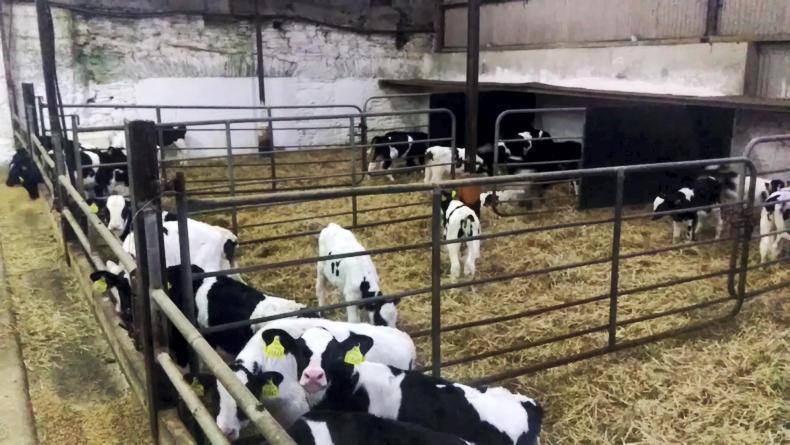The spring calves have done well this year. It is a huge relief given the crypto scour problems and losses of last year.
It is always good to sit back a little and analyse the season as it nears an end.
So what changed? The biggest change was what I wrote about last week. I delayed the calving start so as to give a proper chance to be ready. The autumn herd complicates things from a health point of view. It is exactly the same as having winter and spring cereal crops.
The winter crop or the autumn born calves provide a reservoir of pests and diseases for the new borns in spring. It means more vigilance is needed.
In hindsight I should have built two calf houses
All my calves share the same airspace. In hindsight I should have built two calf houses. Not an option to change at this stage. Instead the solution is disinfection and airflow.
This year I had two full months between the autumn stragglers and the spring false starters. All the autumn bull calves being sold meant that after weaning the heifers didn’t need as many pens.
I chose a breezy day to reduce lingering mist in the air and washed one half of the house. This was freshly whitewashed with hydrated lime and bedded for the autumn calves, before repeating the operation on the second half.
The difference this year was that this could be done with two weeks to spare before any new arrivals. Drying is as important as disinfection.
On airflow I screwed a 6mm stockboard on the gate at the back of each pen and lowered the overhead baffle board to gate height. It meant that there was no direct airflow between pens where the calves usually lie down. Meanwhile the groups still had contact through the gates while actively feeding and socialising.
Building immunity to fight against infection
The rest was tightening up on hygiene. The Johnnes protocol recommends removing the calf from the calving pen as soon as the cow has licked. I also tried to get the 3litres colostrum in within the recommended two hours.
Wellies and the calf trolley wheels were always washed. The waste milk for the bull calves was pumped from the dairy to a barrel in the calf house, easing work but also reducing the number of times entering the calf house.
In my opinion too much hygiene would mean no build-up of immunity for any inevitable infection, it’s more to reduce any heavy pressure. Some year I’ll get it perfect.
Read more
Farmer Writes: defending farming from mistruths
Farmer Writes: has spring finally sprung?
The spring calves have done well this year. It is a huge relief given the crypto scour problems and losses of last year.
It is always good to sit back a little and analyse the season as it nears an end.
So what changed? The biggest change was what I wrote about last week. I delayed the calving start so as to give a proper chance to be ready. The autumn herd complicates things from a health point of view. It is exactly the same as having winter and spring cereal crops.
The winter crop or the autumn born calves provide a reservoir of pests and diseases for the new borns in spring. It means more vigilance is needed.
In hindsight I should have built two calf houses
All my calves share the same airspace. In hindsight I should have built two calf houses. Not an option to change at this stage. Instead the solution is disinfection and airflow.
This year I had two full months between the autumn stragglers and the spring false starters. All the autumn bull calves being sold meant that after weaning the heifers didn’t need as many pens.
I chose a breezy day to reduce lingering mist in the air and washed one half of the house. This was freshly whitewashed with hydrated lime and bedded for the autumn calves, before repeating the operation on the second half.
The difference this year was that this could be done with two weeks to spare before any new arrivals. Drying is as important as disinfection.
On airflow I screwed a 6mm stockboard on the gate at the back of each pen and lowered the overhead baffle board to gate height. It meant that there was no direct airflow between pens where the calves usually lie down. Meanwhile the groups still had contact through the gates while actively feeding and socialising.
Building immunity to fight against infection
The rest was tightening up on hygiene. The Johnnes protocol recommends removing the calf from the calving pen as soon as the cow has licked. I also tried to get the 3litres colostrum in within the recommended two hours.
Wellies and the calf trolley wheels were always washed. The waste milk for the bull calves was pumped from the dairy to a barrel in the calf house, easing work but also reducing the number of times entering the calf house.
In my opinion too much hygiene would mean no build-up of immunity for any inevitable infection, it’s more to reduce any heavy pressure. Some year I’ll get it perfect.
Read more
Farmer Writes: defending farming from mistruths
Farmer Writes: has spring finally sprung?






 This is a subscriber-only article
This is a subscriber-only article










SHARING OPTIONS: